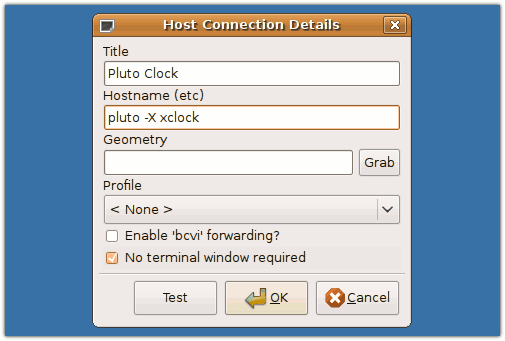Start remote commands without a terminal window
You can use SSHMenu to run commands on remote servers simply by typing the command after the hostname in the 'Host Connection Details' dialog. For example to tail a log file on a web server, you might enter:
www.example.com tail -f /var/log/apache2/access.log
You can also run GUI commands using the '-X' option to enable the X-Forwarding feature of SSH. When you launch a GUI command, you might not want the terminal window that SSHMenu normally provides. This article describes how to add a checkbox to the host dialog to indicate when the terminal window is not required:

As with the other SSHMenu 'hacks' described on this site, modifying the host dialog will not require any changes to the SSHMenu source code. Instead, the modified behaviour will be defined in new classes in a Ruby source file and then the SSHMenu config file will be modified to point to the new classes. For a more detail description of this process, see the article about adding telnet support to SSHMenu and for even more information, refer to the SSHMenu Hacker's Guide.
The first step is to create a file containing the new class definitions. I saved the following code in a file called '/home/grant/ruby/terminal_optional.rb':
require 'gnome-sshmenu'
module TerminalOptional
class App <GnomeSSHMenu::App
def build_window_command(host)
if host.no_terminal
return ssh_command(host) + ' ' + host.sshparams_noenv + ' &'
else
return super(host)
end
end
end
class HostItem <GnomeSSHMenu::HostItem
attr_accessor :no_terminal
def initialize(h={})
super
@no_terminal = true if h['no_terminal']
end
def to_h
h = super
h['no_terminal'] = true if no_terminal
return h
end
end
class HostDialog <GnomeSSHMenu::HostDialog
def add_other_inputs
super
@no_terminal = Gtk::CheckButton.new( "No terminal window required", false)
@no_terminal.active = true if @host.no_terminal
@body.pack_start(@no_terminal, false, true, 0)
end
def dialog_to_host(host=nil)
host = super(host)
host.no_terminal = @no_terminal.active?
return host
end
end
end
The next step is to modify the SSHMenu config file to point to these new classes. The config file is a YAML file called .sshmenu in your home directory. By default, the config file will contain an empty 'classes' definition that looks like this:
classes: {}
I changed that part of the file to look like this (note the empty curly braces and the blank line were both removed and four extra lines added):
classes: app: TerminalOptional::App app.dialog.host: TerminalOptional::HostDialog app.model.hostitem: TerminalOptional::HostItem require: /home/grant/ruby/terminal_optional.rb
The final step is to restart SSHMenu. To achieve this, you could remove the applet from the panel and add it back, or you could log out and back in.
That's all there is to it.